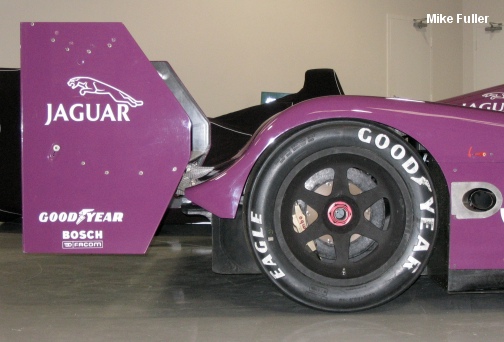 The rear wing is easily the
most notable detail on the XJR-14. Rival
teams initially protested the concept saying that the lower tier was
merely an extension of the diffuser and thus should be regulated as
such. But in spite of all their noise, the Jaguar's
competitors never officially took the matter to FISA.
The rear wing is easily the
most notable detail on the XJR-14. Rival
teams initially protested the concept saying that the lower tier was
merely an extension of the diffuser and thus should be regulated as
such. But in spite of all their noise, the Jaguar's
competitors never officially took the matter to FISA.
At the XJR-14's debut at Suzuka, the #4 Brundle Jaguar fell afoul the scrutineers and had it's initial Thursday qualifying times thrown out over an issue with the rear wing's height and how that measurement should be taken. FISA contented height measurements were taken from the lowest point on the reference plane. TWR contented that this didn't make any sense as this method didn't take chassis rake into account and that height measurements should actually be measured perpendicular to the reference plane itself.
The end result was that the stewards made the #4 car lower the upper tier by 70 mm. This had precious little effect on the car's performance, much to TWR's competitor's consternation.
The long chord twin element lower wing worked to enhance the flow through the underbody while the short chord twin element upper tier was essentially a trim device used to alter balance and increase overall downforce as needed.
 Rival
team's primary focus of protest was the relationship between the
trailing edge of the underfloor and the lower mainplane. As
you
can see there is but a few inches in height separation between the two
and the thought was the FISA should deem the lower wing an
extension of the diffuser. Ultimately nothing materialized
from the rival rumblings, after all,
the XJR-14 was little different in execution than what Southgate had
been doing for years on the V12 Le Mans Jaguars.
Rival
team's primary focus of protest was the relationship between the
trailing edge of the underfloor and the lower mainplane. As
you
can see there is but a few inches in height separation between the two
and the thought was the FISA should deem the lower wing an
extension of the diffuser. Ultimately nothing materialized
from the rival rumblings, after all,
the XJR-14 was little different in execution than what Southgate had
been doing for years on the V12 Le Mans Jaguars. The
XJR-14’s tunnel exits are free from
obstructions but for the lower A-arms.
Here
we can see the proximity of the lower-tier of the rear wing to the
tunnel
exit. The XJR-14
raced to Group C
underfloor regulations and hence the
tunnel exit height was to the regulated 280 mm and comparatively low. The outer corners of the
tunnels are
chamfered to provide clearance for the rear pushrods and taking them
out of the airflow.
The
XJR-14’s tunnel exits are free from
obstructions but for the lower A-arms.
Here
we can see the proximity of the lower-tier of the rear wing to the
tunnel
exit. The XJR-14
raced to Group C
underfloor regulations and hence the
tunnel exit height was to the regulated 280 mm and comparatively low. The outer corners of the
tunnels are
chamfered to provide clearance for the rear pushrods and taking them
out of the airflow. The
aerodynamic advantages of the twin tier rear wing set up were rather
significant. The long chord lower tier helped "excite" the
airflow going through the diffuser, improving efficiency. In
conjunction with the adjustable front wing, the short chord upper tier
mainplane and flap allowed for increased overall down force levels and
maintained balance with increasing front flap angle.
The
aerodynamic advantages of the twin tier rear wing set up were rather
significant. The long chord lower tier helped "excite" the
airflow going through the diffuser, improving efficiency. In
conjunction with the adjustable front wing, the short chord upper tier
mainplane and flap allowed for increased overall down force levels and
maintained balance with increasing front flap angle.Ultimately the origins of the concept lays within the work done by Southgate. Consider that Brawn would have been hard pressed to have ignored contemporary sportscars up to the point of his tenure at TWR, not to mention the reams of data at his disposal (naturally generated by Southgate).
The flick up feature on the XJR-14's tail (the Duck's Arse or DA) was a late addition. Wind tunnel development was ongoing while the manufacture of the car was in process and a story is relayed that tells of wet gel coat being scrapped off the engine cover pattern in order to include this last minute change.
The end result was the XJR-14 generated 5880 lbs. of downforce for 1400 lbs. drag (figures quoted at 200 mph). Brawn et al effectively matched Tony Southgate on their first attempt.
Absolute downforce numbers increased substantially when the XJR-14 was brought to IMSA simply because downforce was the only thing that mattered. In typical IMSA configuration the XJR-14’s downforce could be increased to 7800 lbs. with 1700 lbs. drag. Though when the situation called for it, amazingly even more downforce could be extracted; Ian Reed, TWR USA Technical Director, “We did some aero development at
